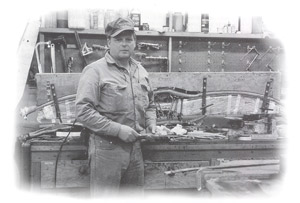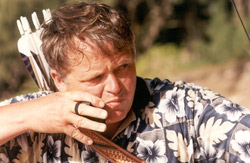![]()
 |
![]()
|
Interview with Jack B. Harrison, Bowyer Between
Rik Hinton, Editor and Publisher of
Instinctive Archer Magazine and Jack B. Harrison (Note: This Interview was
modified and updated from the original that appeared in Rik: Jack, you have been building bows now since 1985. Why did you ever start? Jack: I was moving to Alaska from Oregon where I lived in Greshem, the same suburb of Portland where the late Jim Brackenbury lived. I spent quite a bit of time with Jim and through his encouragement I decided to make bows. It all came about one day when I asked Jim why someone didn't build a two-piece, takedown longbow. I asked him to make me one and he declined. He told me to do it myself. So, after I settled in Anchorage, I decided to go ahead and do it. Rik: Was the takedown your first bow? Jack: Yes. I eventually started building one-piece longbows, but the Black Wolf was my first model. The HHC, one-piece longbow is my latest. There are 5 different models, three takedowns and two one-piece longbows. Rik: You don't build a recurve? Jack: No. Rik: Why not? Jack: My longbows shoot with any recurve, so why go to all the effort? Rik: That's a bold statement, isn't it? Jack: No, not as long as these longbows keep performing like they do! Rik: What is it about your longbows that makes them perform like recurves and exactly why do you compare them to recurves? Jack: First of all, most recurves are smooth. They don't stack. Most are quiet. In general, most recurves are known for shooting faster than longbows, and the better ones cast arrows with no handshock at all. Two of the main reasons for their high performance are first, a heavier riser, and second, the recurved limbs. A heavy riser will help absorb and dampen handshock. The recurved limbs are actually pre-stressed in the bow form. The results of pre-stressing a bow limb produces a higher recovery rate in the finished recurve bow, compared to any typical longbow. The increased stress and the reduced limb mass makes recurved-limbs shoot arrows faster.
The riser of my takedown long bow is a full pound heavier than any one-piece longbow. The sleeve fastener is the reason for the added weight. 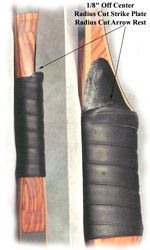 This
added weight helps eliminate handshock. This
added weight helps eliminate handshock. The taper of my limbs is faster than most longbows. The edges are ground in a trapezoid shape from belly to back. This is the opposite of what everyone else does. Building the limbs in this fashion removes excess mass. The last one-third of the ends of the limbs are reflexed just enough to increase stress, but not enough to make it a recurve. By either reflexing or recurving limb tips in any bow, mass can be reduced and stress increased. This increase in stress with less mass increases the elasticity or recovery rate of the limbs, without compromising stability. The effect increases arrow velocity. Handshock is also eliminated. The deflex design in the limbs makes the limbs recover more in an outward vector, compared to a forward vector like most straight-limbed longbows. Any residual vibration from the top limb is cancelled by residual vibration from the bottom limb because they both move in opposite directions away from the center of the bow more, instead of forward. Rik: What's that about that trapezoid shape again? How does that affect the limbs?
Carbon laminations are very light in weight compared to fiberglass. Tempered bamboo laminations physically weigh less than most of the common limb laminations that bowyers use today. So, with less physical weight in the limbs from building them from physically lighter weight materials, handshock is reduced and elasticity is increased. Rik: You lost me! This all seems confusing to listen to all these little details. You cannot expect the average guy who shoots a longbow to follow all that do you? Jack: No, but if he shoots one of my bows, he will realize the benefits without all the mumbo-jumbo about mass, weight, recovery rate, vectors of movement and the rest of that "physics stuff". Rik: Your bows cost more than any bow I have seen advertised. I can't imagine paying over a $1000 for a bow! Jack: Why not? If you ask anyone how many bows they have purchased in the past few years, most people respond with an average of 3 - 4. The average cost of most well made recurves or longbows runs more than $500 each. You do the math! How many bows have you gone through in the past three years? Why do you keep changing? Rik: Well, I have several. But there is only one that I prefer. Jack: Ah, let me guess which one! Rik: The truth is, most people have a closet full of bows. If you add up the total amount spent on all of them it is more than what you ask for any one of your bows. Jack: Right; my point exactly. It takes me three days to build one bow. I have more than $250 in expense in each one. That does not add up to a high-dollar outfit by any stretch of the imagination. I can only build 10 bows a month. That means, in order to stay in business, I have to charge more. But, I feel the quality is worth every penny. These bows shoot well and look great! With the development of my last bow, the Hill style, one-piece, I call the HHC I even surprised myself. It is a commemorative longbow that pays respect to the late Howard Hill. It shoots with no handshock, no stack and it is smooth as glass. What's more, it is quiet and quick. For a Hill style longbow it is in a class all its own. Actually, I was encouraged to build it by one of my dealers. Fred Anderson was the inspiration behind it. My dealer sent me one of Fred's bows to refinish. My dealer called it a Hill style longbow. I recognized Fred's bow as a hybrid style longbow that is actually "whip-ended". My dealer convinced me that a whip-ended Anderson style longbow was just as much a Hill style as any. So, based on my dealer's input, I went ahead and designed my present HHC. So, now I offer a longbow with whip-ended limbs, Hill style riser and a variation on Drake style nocks.
So far I have had an exceptional reception for this bow. Rik:
Well, Jack, enough with the bows, what about you? You were in
business for a long time and then you seemed to drop out of
sight. What happened?
Jack: You're right Rik. I was hurt working in the oil patch back in September 1993. Between 1993 and 1998 I was on "sick leave". I went through a series of 5 surgeries to fix broken bones, torn muscles and ligaments. It was intense. For the longest time, I went without knowing the exact nature of my problem. Until the orthopedic surgeon opened up my back, he didn't realize that I had a failed bone graph/fusion caused by an injury. Before the surgery, even cancer was not ruled out. Between the pain and the drugs, I was limited in what I could do on bows and anything else, for that matter. Rik: I'll bet it about drove you crazy! Jack: It did, and that ought to explain a lot! I spent most of my time "feeling bone grow". That's kind'a like watching the pot boil. No, I had my moments, but I tried to make the best of it and work on my book. One of these days I'll finish it. I need lots of help on it. I'm looking for volunteers. Any suggestions? Rik: Don't look at me. I have more on my plate than I can handle now. Jack: Yea, but you are the guys that get things done. I just need a little direction. If writing is anything like bowmaking, the guys who do it all the time are better at it than those of us who are wannabes. Rik: Well, . . . . Jack: Just let me interject with the rest of the story before you OD on guilt! I got better. Right after I returned from my trip to Africa in 1998 the doctors did my last surgery on my shoulder. It has been more than two years now and I have done well on recovery. Africa is enough to give anyone a new lease on life! Now I'm back up to bench-pressing 185#. That's good for me. I can also handle a heavier bow too, 60#. In December, 1999 I had a ball with friends in Texas hunting exotics. Now I am up and running again, doing my own thing under Harrison Longbows. Alaska Frontier Archery is now owned and operated by Steve Tanner. He is doing the Forgewood arrows. The bowmaking half of AFA went down the drain in 1997 just before the doctors performed corrective surgery on my lower back. In any event, because I was the only one who was up to bowmaking, I went off on my own. Today, I am the only one in the shop. I get help from neighbors and a couple "believers", who are retired and enjoy helping me out. Each month I have increased my bowmaking activity and sales. As I mentioned earlier, I am certain the HHC will be one of my best selling bows ever. It is remarkable how well it performs. The price is right too. Many people do not need a takedown. Between the HHC and the American Wolf, I have the segment of the market covered now that most people can afford. I am extremely pleased with the Hill style bow. It amazes me that it shoots so well without stacking and without handshock. Rik: So, it sounds like you are on a roll again. Jack: Yea, it really feels good. I didn't realize how badly I felt until I got better! As rediculous as that might seem, it dawned on me one day just how far down I had slipped. It feels so good to be looking forward to a bright future with my new business. Rik: I understand you tried to do something in Africa in 2000 too; a safari school? Jack: That's right, my 1998 safari was great, but I paid too much for what I got. One thing about spending too much for too little, its an expensive education. Rik: What happened? Jack: Well, it is long story, but suffice to say, I originally had to postpone my 1995 safari and original booking date because of my injuries. Then later, I had to take what was available or forfeit my deposit. The 1998 trip was a great experience, but it was nothing like it was originally planned and paid for. Rik: How did you get involved with the safari school? Jack: The upshot of my 1998 African experience was to organize a bowhunting safari school for 2000. The Mokore Bowhunting School article in the Fall issue of IA described it, but we didn't get enough participation to pull it off. Very few people were interested in going over there with all the political problems. Frankly, postponing it was probably not necessary, but nobody felt like taking any chances. We are still thinking about doing a trip in 2001 or 2002. We will stick to the Republic of South Africa or Namibia, however. We are working with Derek Nourse, a local guide and he has set some things up for a small group of bowhunters who would like to hunt plains game only. Rik: Does an African safari cost a lot? Jack: Africa is very affordable, but it takes some careful planning to pull a safari off without getting hooked into excess costs. Getting the right group together with the right safari operator is a win win situation. Dealing directly with the Africans seems to work well, and I am thrilled with Derek as a contact. Rik: What happened to your boot-camp idea that you talked about before? Jack: Nothing! No one was interested. So, we dropped it. Now, there is just a small group of my friends going over together to bowhunt. Rik: Well, Jack, I know this is asking a lot, but what do you think of the future of bowhunting? Jack: To me it looks better and brighter than ever, but, that's like asking a drunk who just got back on the wagon again! I'm an "elk-o-haulic", who's been dry for more than 6 years now. No telling what goes on in my mind! I know there are many people who disagree with me, but I see bowhunting growing, along with the opportunity to hunt. If for no other reason it will increase because guns are getting a lot of bad press. Many of the people affected will seek some sort of compromise to continue to enjoy and preserve traditional hunting. What better way is there than bowhunting? As gun banning becomes more and more politically correct, the logical response will be to take up the bow and arrow to hunt. Still, on the other side of the coin, there is the argument that any ban on guns will precipitate a ban on hunting in general. I find this too improbable. The life cycle of most animals is short; they multiply and grow at tremendous rates, compared to the "life cycle" of any one political agenda. Just as soon as there are "too many" critters at any one time, those who advocate political correctness will seek out practical solutions regardless of what their "political orientation" might be. Plus, if the critters become too numerous, even our own species is at risk. Just where do the politicians think all the Flu viruses come from? Nature generally takes care of over-population with disease. I think the real endangered species today are humans. Long before hunting is banned, I feel the human race is more likely to be brought up short with the results of widespread pandemics, to say nothing of the mess from wars that politics precipitate. That alone will shift the attention of any contemporary political agenda of any special interest group. When we entered the 21st Century, there was all that stuff on the History channel and Discovery. Even Tom Brokaw got into the act with a TV special on the last century. People don't seem to recall that the body count for the last century was right at 100 million people murdered; that's a million for each year of the last century. The bad guys were all politicians backed by armies of thugs. If bowhunters are threatened today at all it will probably come from that same quarter, but it won't be over a fight to keep and bear arms, or hunt. There are still a lot of bad guys out there with their own political agendas who will be rattling their sabers. Biological terrorism is just coming of age. Maybe the mental giants who we all voted for will realize there are more important matters to get off on, besides bowhunters and the "crops of harvestable game". Rik: That's pretty heavy, Jack! Jack: Well, you asked me . . . Rik: Any parting words of encouragement to our readers? Jack: Yea; as my Tlingit friends say, "It just keeps getting better . . . " And you thought Bill W. was the first person to quote that! Rik:: Jack, you're not all there . . . . .
|
||
Home
| One-Piece Longbows | Takedown
Longbows | Options/Accessories | What's
New
Interview |
Trophy
Photos | African
and United States Contacts
| Questions
or Comments
__________________________________________________________

Fisk
Longbows
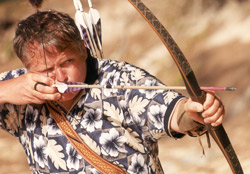
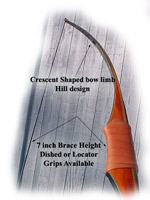 Well,
all this can be accomplished by building a longbow with the right
materials, using the right design. By combining bamboo and carbon
in the limbs, I build longbow limbs that recover as quickly as most
of the recurves that are sold on the market today that hunters use.
Remember that I am building a hunting longbow, so, I compare it
to hunting recurves. The late Harry Drake built lots of recurves
that cast better than most bows of any kind, including most high-tech
compounds. The point is my focus is on longbows that are used to
hunt with.
Well,
all this can be accomplished by building a longbow with the right
materials, using the right design. By combining bamboo and carbon
in the limbs, I build longbow limbs that recover as quickly as most
of the recurves that are sold on the market today that hunters use.
Remember that I am building a hunting longbow, so, I compare it
to hunting recurves. The late Harry Drake built lots of recurves
that cast better than most bows of any kind, including most high-tech
compounds. The point is my focus is on longbows that are used to
hunt with.
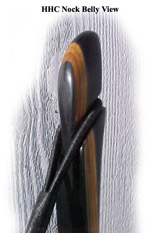 Jack:
The trapezoid shape from the belly to the back eliminates excess
mass. By eliminating excess mass the limbs recover faster. The reason
this can be done is because the carbon is stronger in tension on
the back of the bow, compared to the belly of the bow. Removing
the excess mass from the back of the bow does not weaken or compromise
the integrity of the limbs because of the added strength of the
carbon. It is also physically lighter in weight. Because of its
lightweight and high stress it recovers faster in combination with
bamboo. Again, handshock is reduced. Pre-stressing both the carbon
and the bamboo laminations by reflexing them in the bow form increases
stress and allows me to taper them faster, thus reducing mass again.
With less mass built into the last third of the limbs, handshock
is reduced. Where have I said that before?
Jack:
The trapezoid shape from the belly to the back eliminates excess
mass. By eliminating excess mass the limbs recover faster. The reason
this can be done is because the carbon is stronger in tension on
the back of the bow, compared to the belly of the bow. Removing
the excess mass from the back of the bow does not weaken or compromise
the integrity of the limbs because of the added strength of the
carbon. It is also physically lighter in weight. Because of its
lightweight and high stress it recovers faster in combination with
bamboo. Again, handshock is reduced. Pre-stressing both the carbon
and the bamboo laminations by reflexing them in the bow form increases
stress and allows me to taper them faster, thus reducing mass again.
With less mass built into the last third of the limbs, handshock
is reduced. Where have I said that before? 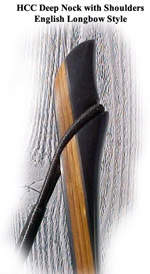 As
an added feature, I introduced the Drake style nocks on the HHC,
Hill style longbow. They remind me of the old style English nocks
on the yew wood bows they made with horn nocks. These nocks are
made with a modified shoulder. The shape of the limb at the nock
on the belly side of the bow is similar to the profile of the nock
loop in the string. This style nock helps center the string down
the limb and it is quieter than those that are built with shoulders
that are narrow. A while back I discovered that a great deal of
noise is emitted from the shoulders of the nock where the string
loop contacts it on either side. With the deeper shoulder, which
keeps the string in contact with the nock as the bow is drawn and
shot, the bow shoots quieter.
As
an added feature, I introduced the Drake style nocks on the HHC,
Hill style longbow. They remind me of the old style English nocks
on the yew wood bows they made with horn nocks. These nocks are
made with a modified shoulder. The shape of the limb at the nock
on the belly side of the bow is similar to the profile of the nock
loop in the string. This style nock helps center the string down
the limb and it is quieter than those that are built with shoulders
that are narrow. A while back I discovered that a great deal of
noise is emitted from the shoulders of the nock where the string
loop contacts it on either side. With the deeper shoulder, which
keeps the string in contact with the nock as the bow is drawn and
shot, the bow shoots quieter.